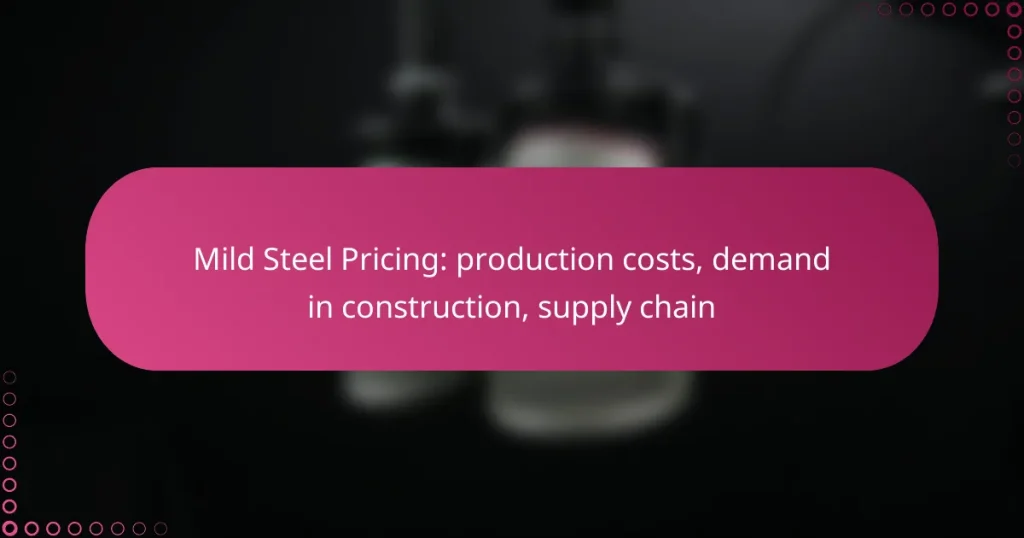Mild steel pricing in the UK currently ranges from £600 to £800 per ton, influenced by production costs, demand in the construction sector, and supply chain factors. The manufacturing expenses, including raw materials and labor, play a crucial role in determining these prices. Given its versatility and strength, mild steel remains a vital material in construction, driving consistent demand across various projects.

What is the current pricing of mild steel in the UK?
The current pricing of mild steel in the UK typically ranges from £600 to £800 per ton, depending on various market factors. Prices can fluctuate based on demand, production costs, and supply chain dynamics.
Average price per ton
The average price per ton of mild steel in the UK has seen variations due to market conditions. As of late 2023, prices generally hover around £700 per ton, but can vary based on specific grades and market demand. It’s advisable for buyers to check current market rates regularly to secure the best deals.
Factors influencing price fluctuations
Comparison with global prices

How do production costs affect mild steel pricing?
Production costs significantly influence mild steel pricing by determining the overall expenses incurred during its manufacturing. Factors such as raw materials, manufacturing processes, and labor costs play critical roles in shaping the final price of mild steel in the market.
Raw material costs
Raw material costs are a primary driver of mild steel pricing, as they account for a substantial portion of production expenses. Key materials include iron ore, scrap steel, and alloying elements, which can fluctuate based on market demand and availability. For instance, when iron ore prices rise due to increased global demand, mild steel prices typically follow suit.
Additionally, sourcing materials from different regions can affect costs. For example, importing raw materials may incur shipping fees and tariffs, further impacting the final price of mild steel. Manufacturers often monitor these costs closely to adjust pricing strategies accordingly.
Manufacturing processes
The manufacturing processes used to produce mild steel also affect its pricing. Techniques such as electric arc furnace (EAF) and basic oxygen furnace (BOF) have different energy requirements and operational costs. EAF, which primarily uses scrap steel, can be more cost-effective when scrap prices are low, while BOF relies on iron ore and can be more expensive during ore price spikes.
Efficiency in manufacturing can lead to cost savings, which may be passed on to consumers. For example, advancements in technology that reduce energy consumption or improve yield rates can help lower production costs, potentially stabilizing or reducing mild steel prices.
Labor costs in the UK
Labor costs in the UK significantly impact mild steel pricing, as skilled labor is essential for efficient production. The UK has seen rising labor costs due to factors such as minimum wage increases and skill shortages in manufacturing. These rising costs can lead to higher overall production expenses, which may be reflected in the pricing of mild steel.
Manufacturers often seek to balance labor costs with productivity improvements. Investing in automation and training can help mitigate labor cost increases, allowing companies to maintain competitive pricing while ensuring quality production standards are met.

What is the demand for mild steel in the construction industry?
The demand for mild steel in the construction industry is significant due to its versatility, strength, and cost-effectiveness. It is widely used in structural applications, reinforcing bars, and various construction components, making it a staple material in building projects.
Current demand trends
Current demand trends for mild steel are influenced by a resurgence in construction activities, particularly in residential and commercial sectors. As economies recover post-pandemic, many countries are witnessing increased investments in infrastructure, driving up the need for mild steel.
Additionally, the shift towards sustainable building practices has led to a rise in demand for recycled mild steel, which is often favored for its lower environmental impact. This trend is expected to continue as more construction companies adopt green building standards.
Impact of construction projects on pricing
The pricing of mild steel is closely tied to the volume and scale of construction projects. Large-scale developments typically lead to higher demand, which can push prices up due to limited supply. Conversely, during periods of low construction activity, prices may stabilize or decrease.
Moreover, fluctuations in raw material costs, such as iron ore and scrap metal, also affect mild steel pricing. Construction companies should monitor these factors to better anticipate cost changes and budget accordingly.
Regional demand variations in the UK
In the UK, regional demand for mild steel varies significantly based on local construction activity and economic conditions. Areas with high urban development, such as London and the South East, tend to have stronger demand due to ongoing infrastructure projects and housing developments.
Conversely, regions experiencing economic downturns may see reduced demand for mild steel, impacting local suppliers and pricing. Understanding these regional dynamics is crucial for stakeholders in the construction industry to make informed purchasing decisions.

How does the supply chain influence mild steel pricing?
The supply chain significantly impacts mild steel pricing through various factors such as logistics, supplier relationships, and global disruptions. Efficient supply chains can lower costs, while disruptions can lead to price increases and availability issues.
Logistics and transportation costs
Logistics and transportation costs are critical components of mild steel pricing. These costs can vary based on distance, fuel prices, and the mode of transport used. For instance, shipping mild steel over long distances can add substantial expenses, often leading to price increases of several percent.
Companies can mitigate these costs by optimizing their supply routes and consolidating shipments. Utilizing local suppliers can also reduce transportation expenses, making the overall pricing more competitive.
Supplier relationships and negotiations
Strong supplier relationships can lead to better pricing and more favorable terms for mild steel procurement. Negotiating bulk purchase agreements or long-term contracts often results in discounts, which can significantly affect overall costs.
Building trust with suppliers can also ensure priority during high-demand periods, helping to stabilize prices. Companies should regularly evaluate their supplier agreements to ensure they are receiving the best possible terms.
Impact of global supply chain disruptions
Global supply chain disruptions, such as geopolitical tensions or natural disasters, can drastically affect mild steel pricing. These disruptions can lead to shortages, causing prices to spike due to increased demand and limited supply.
Businesses should stay informed about global events that could impact their supply chains and consider diversifying their sources to minimize risks. Having contingency plans in place can help manage costs during unforeseen disruptions, ensuring more stable pricing.

What are the key factors affecting mild steel pricing in Europe?
Mild steel pricing in Europe is primarily influenced by production costs, demand in the construction sector, and supply chain dynamics. Fluctuations in raw material prices, energy costs, and market demand can significantly impact overall pricing trends.
Regulatory impacts
Regulatory frameworks in Europe can have a substantial effect on mild steel pricing. Compliance with environmental standards and safety regulations often increases production costs, which can be passed on to consumers. For instance, stricter emissions regulations may require manufacturers to invest in cleaner technologies, raising overall expenses.
Additionally, regulations regarding recycling and waste management can influence the availability of scrap steel, a crucial input for mild steel production. Changes in these regulations can lead to fluctuations in supply and, consequently, pricing.
Trade tariffs and their effects
Trade tariffs imposed on imported steel can significantly affect mild steel pricing in Europe. Higher tariffs can lead to increased costs for imported materials, which may prompt domestic manufacturers to raise their prices to maintain profit margins. For example, tariffs on steel from non-EU countries can create a price disparity between domestic and imported products.
Moreover, trade agreements and negotiations can alter the landscape of steel pricing. Favorable trade terms may reduce costs, while ongoing trade disputes can lead to uncertainty and volatility in pricing, impacting both consumers and suppliers in the market.

How to choose suppliers for mild steel?
Choosing suppliers for mild steel involves evaluating their reliability, pricing, and quality of materials. Key factors include production costs, responsiveness to demand in construction, and the efficiency of their supply chain.
Criteria for selecting suppliers
When selecting suppliers for mild steel, consider their production capacity, quality certifications, and delivery reliability. Look for suppliers who adhere to industry standards such as ISO certifications, which can indicate a commitment to quality and consistency.
Pricing is another critical factor; compare quotes from multiple suppliers to ensure competitive rates. Additionally, assess their responsiveness to market demand, especially during peak construction periods, as this can affect lead times and availability.
Comparative analysis of top suppliers
To effectively compare top suppliers, create a matrix that includes key criteria such as price per ton, delivery times, and customer service ratings. This visual aid can help you quickly identify which suppliers meet your specific needs.
For example, a supplier offering mild steel at $600 per ton with a delivery time of one week may be preferable to one charging $550 but with a two-week lead time. Evaluate customer reviews and case studies to gauge the reliability and performance of each supplier in real-world scenarios.


